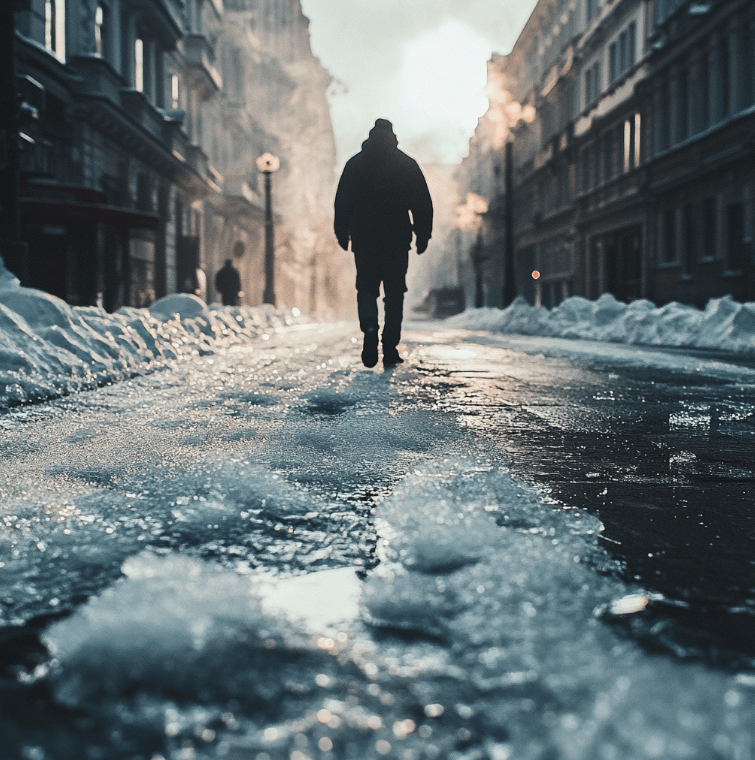
Winter in Maryland often transforms streets and sidewalks into treacherous surfaces. If you’ve ever experienced the shock and pain of a slip on the ice, you’re not alone. Did you know that "falling on black ice" is one of the most common and dangerous hazards during icy weather?
Understanding your legal rights and how to hold property owners accountable can make all the difference in seeking compensation. In this article, we’ll explain what your rights are after you slip on ice and whether or not you’re entitled to compensation.
You’ll also learn:
Let’s begin by going over property owner obligations for slip-and-fall accidents involving ice.
In Maryland, the obligation to maintain safe conditions for visitors during hazardous winter weather often depends on local ordinances, which vary by municipality. Some areas may require property owners to clear ice and snow, while others do not impose this duty.
Property owners may be required to act within specific timeframes to remove snow and ice, as dictated by variable local ordinances. For instance, Baltimore requires snow removal within 3 hours after a snowfall ends, except during nighttime hours. Different rules apply when a storm is still in progress.
If a property owner fails to act within a reasonable period, they could be held responsible for injuries resulting from their negligence.
Property owners are expected to:
Failure to meet these obligations can lead to serious accidents, particularly those involving falling on black ice — which is nearly impossible to see.
Slipping on icy surfaces can lead to significant injuries, ranging from fractures to concussions. After such an incident, you have the right to seek compensation for your losses, provided you can prove the property owner’s negligence.
Victims of ice-related accidents may pursue compensation for long-term effects, such as rehabilitation costs or permanent disability. Keep in mind such claims require substantial evidence, including medical documentation and expert testimony, to prove their validity.
After a slip on the ice, it’s crucial to act quickly to protect your rights:
Medical documentation plays a key role in proving the severity of your injuries. Don’t delay in seeking a professional evaluation.
Winning an ice slip-and-fall lawsuit requires proving that the property owner’s negligence directly caused your injuries. This often involves gathering solid evidence to support your claim.
Evidence is essential for establishing negligence. Key pieces include:
To hold a property owner liable, you must show they knew — or should have known — about the dangerous conditions. This can include:
In some cases, expert testimony may be required to explain how inadequate property management caused or contributed to the accident.
Maryland’s laws add unique challenges for slip and fall cases. Understanding these obstacles is crucial if you’re planning to pursue legal action. Let’s look at some challenges you might face along the way:
Maryland follows the contributory negligence rule, meaning that if you are found even 1% at fault for the accident, you may be barred from recovering compensation.
However, the application of this rule depends on the defense’s ability to prove the plaintiff’s negligence contributed to the incident.
If you knowingly walked on a visibly icy area, the defense may argue that you assumed the risk of injury, weakening your claim. This defense is especially common in cases involving black ice, as it’s harder to prove visibility.
Maryland law generally gives victims three years from the date of the accident to file a personal injury lawsuit. However, claims against government entities or certain municipalities may have shorter deadlines, such as 180 days to provide notice.
To build a strong case, it’s important to gather evidence, avoid mistakes, and seek legal guidance early in the process. Let’s zoom into these recommendations:
Save everything related to your case, including:
Keeping a detailed journal of how your injuries impact your daily life can also help demonstrate the severity of your damages.
Common mistakes that can undermine your case include:
An experienced attorney can help you navigate Maryland’s legal landscape, gather evidence, and ensure your case is as strong as possible.
If you’ve been injured in a slip on the ice, having the right attorney by your side is key. Christopher Beard understands the challenges of pursuing an ice slip and fall lawsuit in Maryland’s legal system.
Christopher Beard is a trusted Maryland attorney with extensive experience in handling slip and fall cases, particularly those involving icy conditions. His approach combines in-depth legal expertise with meticulous evidence gathering to build compelling cases for his clients.
From investigating the scene of your fall to collaborating with experts, Attorney Beard ensures no detail is overlooked. His goal is to secure the compensation you deserve for your injuries and losses.
Call (443) 569-3950 today or schedule a free consultation. Let us help you hold negligent property owners accountable and get you back on your feet. Remember: Taking action protects your rights and helps make Maryland a safer place during winter’s icy grip.